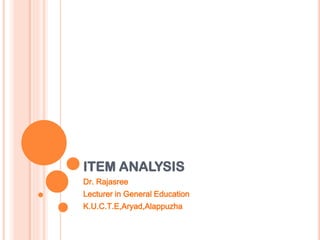Report
Share

Recommended
More Related Content
What's hot
What's hot (20)
Basic Concepts of Teaching, Evaluation, Measurement, And Tests.

Basic Concepts of Teaching, Evaluation, Measurement, And Tests.
Viewers also liked
Game On! (@gameontext – http://game-on.org) is an awesome throwback text-based adventure built with microservices. Completely open source, it enables everyone to choose their own adventure to learn about microservices concepts while extending the game. One of the core services is the Map, which maintains a two-dimensional map containing all the registered rooms. The Map started with a document store as a back end, but as the Map changed over time, tombstones started to accrue. And then people started to ask how to manage three dimensions, and dragons appeared. Come to this session to find out why the decision was made to change the NoSQL back end, how it was done, and the result of the change with a new NoSQL API (http://jnosql.org/).JavaOne 2017 - Choosing a NoSQL API and Database to Avoid Tombstones and Drag...

JavaOne 2017 - Choosing a NoSQL API and Database to Avoid Tombstones and Drag...Leonardo De Moura Rocha Lima
Viewers also liked (20)
Metrics, Logs, Transaction Traces, Anomaly Detection at Scale

Metrics, Logs, Transaction Traces, Anomaly Detection at Scale
IBM Bluemix OpenWhisk: IBM Seminar 2016, Tokyo, Japan: The Future of Cloud Pr...

IBM Bluemix OpenWhisk: IBM Seminar 2016, Tokyo, Japan: The Future of Cloud Pr...
JavaOne 2017 - Choosing a NoSQL API and Database to Avoid Tombstones and Drag...

JavaOne 2017 - Choosing a NoSQL API and Database to Avoid Tombstones and Drag...
Similar to Item analysis
Similar to Item analysis (19)
Item Development and Analysis WorksheetStudent Name.docx

Item Development and Analysis WorksheetStudent Name.docx
Administering, analyzing, and improving the test or assessment

Administering, analyzing, and improving the test or assessment
More from Bimel Kottarathil
More from Bimel Kottarathil (20)
Item analysis
- 1. ITEM ANALYSIS Dr. Rajasree Lecturer in General Education K.U.C.T.E,Aryad,Alappuzha
- 2. ITEM ANALYSIS Item analysis is a statistical technique which is used for selecting and rejecting the items of the test on the basis of their difficulty value and discriminating power Item analysis is done for obtaining: Difficulty value (D.V) Discriminative power (D.P)
- 3. OBJECTIVES OF ITEM ANALYSIS: To select appropriate items for the final draft To obtain the information about the difficulty value(D.V) of all the items To provide discriminatory power (D.I) to differentiate between capable and less capable examinees for the items To provide modification to be made in some of the items To prepare the final draft properly ( easy to difficult items
- 4. STEPS OF ITEM ANAYSIS: Arrange the scores in descending order Separate two sub groups of the test papers Take 27% of the scores out of the highest scores and 27% of the scores falling at bottom Count the number of right answer in highest group (R.H) and count the no of right answer in lowest group (R.L) Count the non-response (N.R) examinees
- 5. Difficulty value (D.V): “ The difficulty value of an item is defined as the proportion or percentage of the examinees who have answered the item correctly” - J.P. Guilford The formula for difficulty value (D.V ) D.V = (R.H + R.L)/ (N.H + N.L) R.H – rightly answered in highest group, R.L - rightly answered in lowest group N.H – no of examinees in highest group, N.L - no of examinees in lowest group
- 6. In case non-response examinees available means, The formula for difficulty value (D.V) D.V = (R.H + R.L)/ [(N.H + N.L)- N.R] R.H – rightly answered in highest group R.L - rightly answered in lowest group N.H – no of examinees in highest group N.L - no of examinees in lowest group N.R – no of non-response examinees
- 7. Discrimination index (D.I): “ Index of discrimination is that ability of an item on the basis of which the discrimination is made between superiors and inferiors ” – Blood and Budd (1972) Types of discrimination index (D.I): Zero discrimination or No discrimination Positive discrimination Negative discrimination
- 8. Zero discrimination or No discrimination : Zero discrimination or No discrimination: The item of the test is answered correctly or know the answer by all the examinee’s An item is not answered correctly by any of the examinee Positive discrimination index: Positive discrimination index :An item is correctly answered by superiors and is not answered correctly by inferiors. The discriminative power range from +1 to -1. Negative discrimination index: Negative discrimination index :An item is correctly answered by inferiors and is not answered correctly by superiors.
- 9. The formula for discrimination index(D.I) D.I = (R.H - R.L)/ (N.H or N.L) R.H – rightly answered in highest group R.L - rightly answered in lowest group N.H – no of examinees in highest group N.L - no of examinees in lowest group
- 10. General guidelines for discriminating index (D.I) According to Ebel , D.I Item Evaluation ≥0.40 -Very good items 0.30 - 0.39 Reasonably good but subject to improvement 0.20 – 0.29 Marginal items , need improvement <0.19 Poor items . Rejected or revised
- 11. D.V Item Evaluation 0.20 – 0.30 Most difficult 0.30 - 0.40 Difficult 0.40 – 0.60 Moderate difficult 0.60 – 0.70 Easy 0.70 – 0.80 Most easy Relationship between difficulty value and discrimination power Both (D.V & D.I) are complementary not contradictory to each other Both should be considered in selecting good items If an item has negatively discriminate or zero discrimination, is to be rejected whatever be the difficulty value
- 12. THANK YOU
